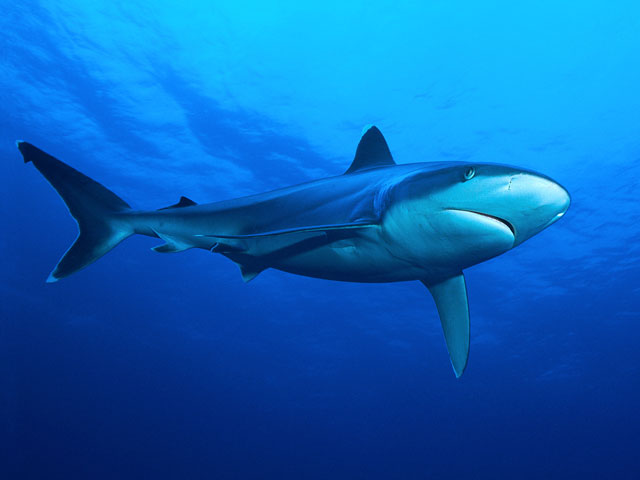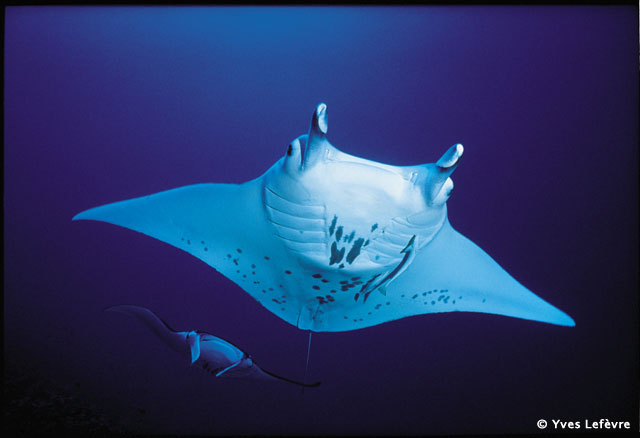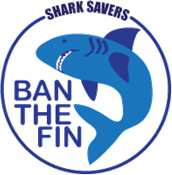
![]()
Tahiti Dive Sites

Among Tahiti's plentiful attributes, there is one in particular that draws divers from around the world and this is the opportunity to dive with vast quantities of one of the marine world's most exciting big animals - the shark. Since the time man first entered the sea, the shark has occupied a prominent place in our minds in the form of both reverence and awe. Some ancient seafarers in the Pacific had even gone as far as to worship the shark as a god. Diving in the Society Islands (Moorea, Bora Bora, Raiatea and Taha'a) offers a variety of dives, from exciting pass diving and shark feeding to shallow lagoon dives. Advanced divers head for the Tuamotus where strong currents guarantee high adrenaline dives with large animal encounters on virtually every dive.
Moorea
Just a short ferry ride northwest from the island of Tahiti is Moorea. Scarcely 37 miles in circumference, Moorea presents an island of spellbinding beauty, with jagged mountain spires built from a volcanic past, blanketed in verdant green and surrounded by crystalline, blue lagoons. However, it is not the formation of the reef that is so dramatic, but rather what cruises around the broad barriers, various passes and outer drop-offs. To the Polynesians, this is the "Kingdom of the Shark." At least five species of sharks can be seen by divers. The lagoon is much smaller here, tidal currents are less intense, and conditions are more suitable for less advanced divers. Gray reef sharks are regulars at some of the sites, but blacktip reef sharks are much more numerous. more ...
Bora Bora
The dramatic peak of Otemanu rises majestically out of the pristine lagoon surrounding the island of Bora Bora. The waters of the lagoon are home to a variety of rays, including mantas and spotted eagle rays which are often seen in large groups of one hundred or more. While out in the open water, sharks, schools of jack fish, barracuda by the hundreds, tuna, marlin and occasionally dolphins and even whales can be seen in this area. more ...
Fakarava
The Garuae pass on the north end of the Tuamotu atoll of Fakarava is French Polynesia's largest pass at nearly a kilometer wide. It is said that seven different currents run through this pass which provide a multitude of encounters with the prolific marine life that inhabits these rich clear waters. During incoming tides, divers will pass through an amazing spectacle - a virtual "wall of sharks" at the mouth of the pass. On the south end divers will find the Tumakohua Pass in an area that has been designated by UNESCO as a nature reserve for the pristine quality of its reefs and ecosystems. more ...

Manihi
Manihi, one of the Tuamotu atolls which houses hundreds of thousands of Black Pearl oysters, is also home to an incredible variety and quantity of fish, sharks, and other various pelagic species. This ring of coral has only one deep water pass called Tairapa. Consequently, all water movements through it are crucial, as is the flow of food which attracts this unique density of sea life, as the tides rise and fall. Truly one of natures gifts, at only 120 feet wide and a half-mile long, it is a great aquarium that can be covered from one end to the other without so much as a single fin stroke due to the mild current which reaches a maximum of three knots.
Raiatea & Taha'a
The islands of Raiatea and Taha'a share the same lagoon and a view of Bora Bora's Otemanu in the distance. Less frequented by tourists, these islands offer a wide variety of activities for the off-the-beaten-track traveler. From the vanilla plantations and black pearl farms of Taha'a to the revered cultural sites of Raiatea, there are many opportunities to learn about the island's cultural roots and meet its people. One of the region's only wrecks, the Nordby, a 150 foot schooner which sank in 1900, is located just fin kicks off Hotel Hawaiki Nui's dock.
Rangiroa
Rangiroa, with its 42 mile long by 16 mile wide turquoise lagoon, is the largest atoll in the Tuamotu Archipelago and the second largest in the world. While Rangiroa might appear as a near perfect oval of reef and land from the air, the chain is not entirely closed. Linking this semi-contained body of water to the outside ocean are two huge, deep-water passes, named Avatoru and Tiputa, after Rangiroa's two villages. On the ocean side, each pass widens to form a broad funnel which is only several hundred yards across. With each tidal change, phenomenal quantities of water pass through both the passes, the flow regularly reaching speeds of five to six knots. The sensation of drifting the entire length of either pass on an incoming tide is as close as one can come to flying through water. During these substantial water changes, large animals including sharks, dolphins, mantas and more will enter the mouth of the passes to feed, sometimes traveling their entire length in the company of divers. more ...

Tahiti
Tahiti offers you your first introduction into the rich, tropical waters of French Polynesia. The incredible biodiversity of the dive sites showcase the rich flora and fauna, from colourful nudibranches to Lemon sharks. Tahiti is also the ideal island to learn scuba diving with some perfect dive sites in the lagoon like "the aquarium" or "the wrecks". more ...
Tikehau
It was in the lagoon of Tikehau that Jacques Cousteau said he had encountered more fish than in any other part of the South Pacific. The pass in Tikehau is a 30-minute boat ride from all the hotels and worth every minute. Here you will see all types of large and small fish; jack fish, sea-pike, barracudas, napoleons as well as gray sharks and manta rays. July through December is the best time to encounter manta rays although it was April when I enjoyed their graceful dance. more ...

